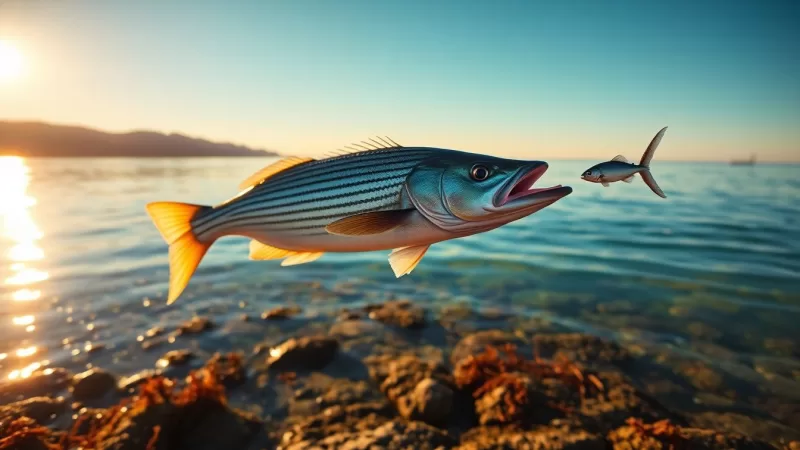Early Season Striper Strategies

Early Season Striper Strategies: Catching Linesiders When They’re Hungry
Remember that first cast of spring? The line sings as it cuts through the air. The anticipation builds with each turn of the reel handle. Early season striper fishing presents challenges, but also incredible rewards. The stripers are hungry. They are eager to chase a well-presented bait or lure.
Early season stripers are unique. They are often concentrated in specific areas. They are also less pressured than later in the year. This article will show you how to find and catch these early-season linesiders. We’ll cover everything from understanding striper behavior to choosing the right gear and mastering effective techniques. Let’s get started.
Understanding Striper Behavior in Early Season
Stripers change their habits with the seasons. Early spring finds them moving from their winter holding areas. They seek warmer waters and food. Understanding these movements is key to finding fish.
Where to Find Them: Key Early Season Habitats
After winter, stripers often gather near river mouths. They also frequent back bays and areas with warmer water outflows. These spots attract baitfish. Look for structure like docks, rocks, or submerged vegetation. These are all places stripers will set up to ambush prey. Identifying these areas can dramatically increase your chances of success.
Water Temperature’s Role
Water temperature plays a huge role in striper activity. Stripers become more active as the water warms. Optimal temperatures for early-season striper fishing are usually between 45 and 55 degrees Fahrenheit. Use a thermometer to monitor water temps. Focus your efforts in areas with the warmest water.
Baitfish Patterns
Stripers key in on specific baitfish during the early season. Herring, bunker (menhaden), and sand eels are common targets. Match your lures and techniques to what the stripers are feeding on. If you see a lot of herring, use lures that imitate them.
Essential Gear for Early Season Striper Fishing
Having the right gear makes a big difference. Early spring conditions and striper behavior demand specific tackle choices. Select the gear that matches your style of fishing.
Rods, Reels, and Lines
Choose rods and reels suited for early-season tactics. Light tackle works well for smaller lures. Heavier gear handles larger baits. A 7-8 foot medium-action rod is a good all-around choice. Match it with a reel in the 3000-4000 size range. Use 10-15 pound test monofilament or braided line. Braid offers better sensitivity and casting distance.
Lure Selection: Matching the Hatch
Lure selection is crucial. Offer stripers what they want to eat. Here are some effective early-season striper lures:
- Crankbaits: Great for covering water quickly.
- Swimbaits: Mimic baitfish like herring and bunker.
- Soft Plastics: Versatile and effective when rigged on jig heads.
- Topwater Lures: Exciting option when conditions allow.
Match the lure size and color to the prevalent baitfish. Clear water calls for natural colors. Murky water requires brighter, high-visibility lures.
Terminal Tackle and Accessories
Don’t overlook terminal tackle. Use quality hooks to ensure solid hooksets. Circle hooks are great for live bait fishing. Fluorocarbon leaders are nearly invisible in the water. Monofilament leaders offer more stretch. Swivels prevent line twist. High-quality tackle prevents lost fish.
Top Early Season Striper Techniques
Mastering effective techniques boosts your success. Let’s look at some proven early-season methods. Adapt them to your local conditions.
Casting Artificials: Mastering the Retrieve
Casting artificial lures is a fun and effective way to catch stripers. Experiment with retrieve speeds. Vary retrieves, and incorporate pauses and twitches. A slow, steady retrieve often works well. Sometimes, aggressive retrieves trigger strikes.
Live Bait Strategies: Presentation is Key
Live bait can be deadly on early-season stripers. Rig live herring or bunker on circle hooks. Keep the bait alive and active. Presentation is crucial. Fish live bait near structure. Use a slow, natural presentation.
Trolling Tactics: Covering Water Effectively
Trolling covers water efficiently. It helps you locate concentrations of fish. Use lures that run at the desired depth. Vary your speed until you find what triggers strikes. Planer boards and downriggers control the depth of your lures.
Location Specific Considerations
Adapt your strategies to your specific location. Early season striper fishing varies along the East Coast. These are some general guidelines.
Northeast Strategies
In the Northeast (New England, New York), focus on river systems. Target herring runs. Use swimbaits and crankbaits to imitate herring. Look for warmer water in harbors and bays. Bunker schools arrive later in the season.
Mid-Atlantic Strategies
In the Mid-Atlantic (New Jersey, Delaware, Maryland, Virginia), target back bays and tidal rivers. Bloodworms are a popular early-season bait. Use them on bottom rigs or under floats. Focus on areas with structure. Look for warmer water outflows.
Conservation and Ethical Angling
Protecting the striper population is everyone’s responsibility. Practice responsible fishing habits.
Catch and Release Best Practices
Handle stripers carefully when practicing catch and release. Use wet hands. Support the fish horizontally. Avoid damaging their gills. Use circle hooks to minimize injury. Revive the fish before releasing it.
Regulations and Size Limits
Always know and follow current striper regulations and size limits. These rules protect the fishery. Report any violations you witness. Be a responsible angler.
Environmental Awareness
Protect the striper’s habitat. Minimize your impact on the environment. Dispose of trash properly. Avoid polluting waterways. Support conservation efforts.
Conclusion: Your Early Season Striper Action Plan
Understanding striper behavior is key. Choose the right gear. Master effective techniques. Practice conservation. These are the keys to early-season striper success.
Get out on the water. Apply what you’ve learned. The thrill of hooking into an early-season striper is hard to beat. Enjoy the experience and respect the fish.

